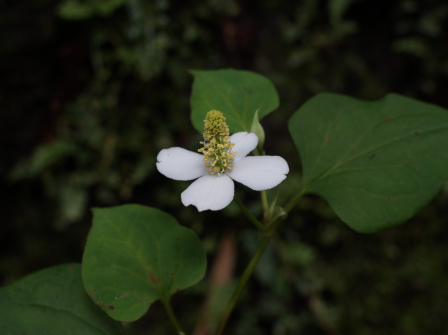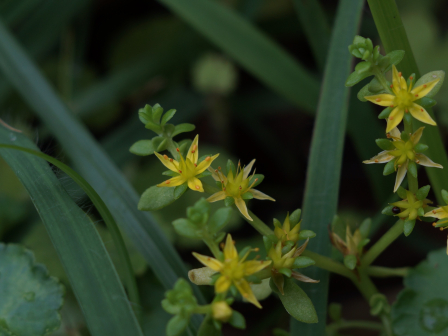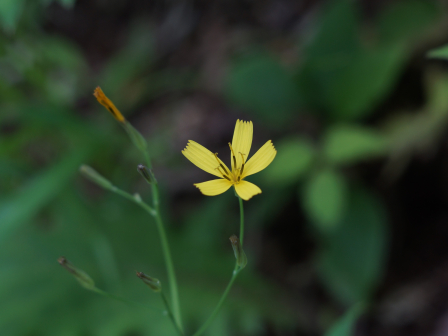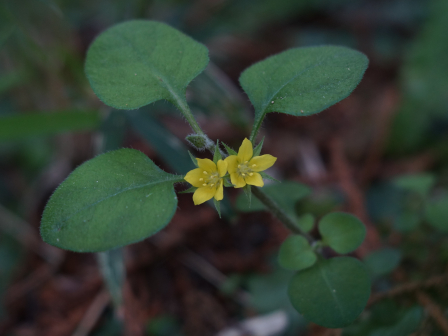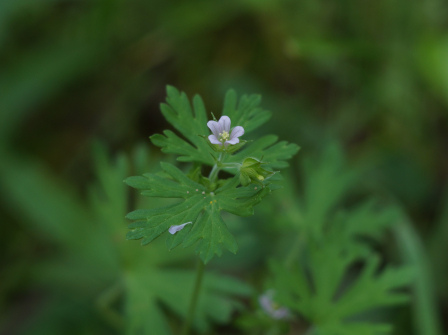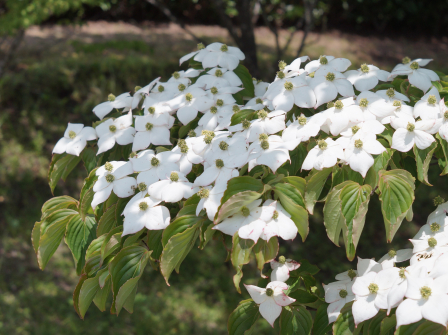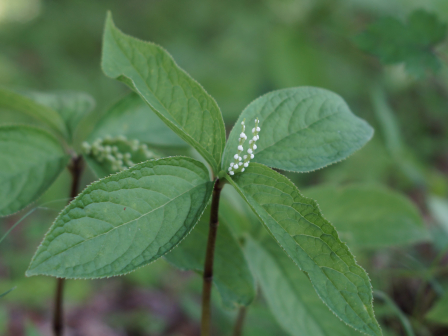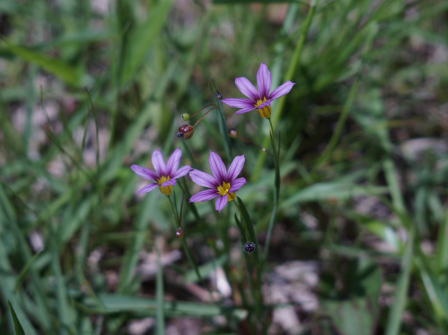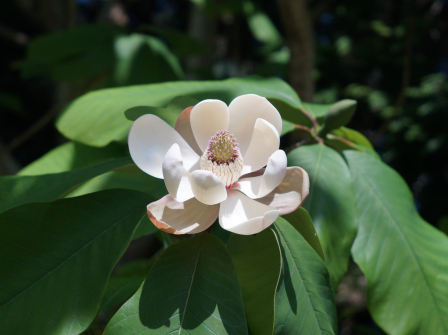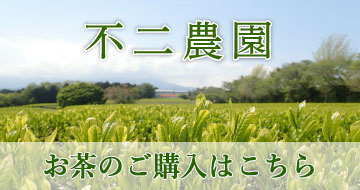フィールド日記
2023.06.16
ドクダミ
ドクダミが咲いています。独特の匂いがする多年生で、日陰でもよく育ちます。4枚の白い花弁をもつように見えますが、白い部分は総苞と呼ばれる花の集まりを包む葉が変化したものです。中央の黄色い部分が小さい花のあつまりで、1つ1つの花は花弁やがくをもたず、1本のめしべと3本のおしべからなります。
"Dokudami (ドクダミ)" plants are in bloom. They are perennial plants that have unique smell. They grow well even in the shade. They look like they have four white petals, but the white parts in the photo that look like petals are not petals. The white parts are called involucre, which are the leaves looking like flowers that wrap the flowers. The yellow part in the center actually consists of flowers. They are a pistil and three stamens and have no petals or sepals.
2023.06.13
コモチマンネングサ
コモチマンネングサが咲いています。道端や植え込みなどでよく見られます。和名のコモチとは子持ちの意味で、葉の付け根にむかごをつけてなかまを殖やすことに由来します。コモチマンネングサは花が咲いても種子ができず、ほとんどむかごによってなかまを殖やしているようです。
"Komochi-Mannengusa (コモチマンネングサ)" plants are in bloom. They usually grow in roadsides and shrubberies. "Komochi (コモチ)" itself means "having children" coming from the fact that they bear the bulbils on the bases of their leaves and leave their offsprings. Even though “Komochi-Mannengusa” plants bloom, they don't produce seeds. Therefore, they almost depend on bulbils for spreading.
2023.06.09
ニガナ
ニガナが咲いています。道端や林縁などに普通に見られるキク科の多年草です。花は5枚の花弁をもつように見えますが、タンポポなど他のキク科のなかまと同様に、1枚の花弁に見える部分が1つの花です。
"Nigana (ニガナ)" plants are in bloom. They are perennial plants belonging to the composite family and commonly seen on roadsides and the edge of forests. The flowers seem to have five petals, but the part that looks like a petal is actually a flower, which is the same characteristic that the other plants also have, such as dandelions, belonging to the composite family.
2023.06.06
コナスビ
コナスビが咲いています。道端や畑地などに普通に見られる小型の多年草です。和名は、花後の果実のようすが小型のナスのように見えることに由来します。しかし、コナスビはナス科ではなくサクラソウ科に属します。
"Ko-Nasubi (コナスビ)" plants are in bloom. They are perennial plants commonly seen in roadsides and fields. The name comes from the fact that, after the flowering period, their fruits look like small eggplants. However, "Ko-Nasubi" belong to the primrose group, not the eggplant group.
2023.06.02
アメリカフウロ
アメリカフウロが咲いています。名前の通り北アメリカ原産の帰化植物で、道端や空き地などでもよく見かけます。在来種のゲンノショウコと似ていますが、アメリカフウロのほうが花期が早く、葉も深く切れ込みます。
"America-Fuuro (アメリカフウロ)'' plants are in bloom. The name indicates that they are from North America. They are often seen in roadsides and vacant lots. "America-Fuuro'' resembles a native species "Gen-No-Shouko (ゲンノショウコ)". "America-Fuuro" blooms earlier and has more deeply lobed leaves than those of "Gen-No-Shouko".
2023.05.30
ハコネウツギ
ハコネウツギが咲いています。花は初め白色ですが、しだいに赤色に変わっていくため、一本の木に白色と赤色の花が混じって咲いているように見えます。和名に箱根とつきますが、全国の沿岸地に広く見られるようです。
"Hakone-Utsugi (ハコネウツギ)" trees are in bloom. Their flowers are white when they start to bloom, and then they gradually turn red. Because of this, it looks like each tree has both white and red flowers. The Japanese name includes "Hakone (箱根)", which is a Japanese town, but "Hakone-Utsugi" trees grow widely in coastal areas in Japan.
2023.05.26
ヤマボウシ
ヤマボウシの花が咲いています。花弁のように見える白い部分は総苞と呼ばれる花の集まりを包む葉が変化したものです。北アメリカ原産のハナミズキ(別名アメリカヤマボウシ)に似ており、どちらも庭木などとして植栽されることが多いですが、ヤマボウシは日本の山地や丘陵地に自生もしています。
"Yamaboushi (ヤマボウシ)" trees are in bloom. The white parts in the photo that look like petals are not petals. They are called involucre, the leaves looking like flowers that wrap the flowers. "Yamaboushi" trees look like "Hanamizuki (ハナミズキ)" trees, which originally come from North America. Both “Yamaboushi” and “Hanamizuki” are often planted in gardens, but "Yamaboushi" trees also grow in mountains and hills in Japan.
2023.05.23
フタリシズカ
フタリシズカが咲いています。和名は能の『二人静』に由来します。写真のように茎の先端に2本の花穂をつけますが、花穂が3本以上のこともよくあります。花は変わった形をしていて、花弁やがくはなく、白い部分は雄しべです。
"Futari-Shizuka (フタリシズカ)" plants are in bloom. The name comes from a play called "Futari-Shizuka" of the Japanese traditional theatrical art "Noh (能)". They bear two flower spikes as you can see in the photo, but they often bear more than three. Their flowers are unique. The flowers have no petals or sepals. The white parts in the photo are their stamens.
2023.05.19
ニワゼキショウ
ニワゼキショウが咲いています。北アメリカ原産の帰化植物で、日当たりのよい芝地などによく見られます。花のあとには球形の果実ができます。和名は、セキショウという植物に葉のつき方が似ていて、庭に生えることに由来します。
"Niwa-Zekishou (ニワゼキショウ)" plants are in bloom. They originally come from North America and often grow in sunny grasslands. After flowering, they bear round fruits. The name comes from the fact that they grow in gardens and that the way their leaves are attached look like the plants called "Sekishou (セキショウ)".
2023.05.16
ホオノキ
ホオノキの花が咲いています。15cmほどの大きな花が咲く落葉高木です。写真の花は開き始めであまり目立ちませんが、雄しべの花糸(葯を支える柄の部分)は赤味を帯びています。葉がたいへん大きいのも特徴で、30cmほどもあり、古くから食べ物を包んだり、盛ったりするのに使われてきました。
"Hoo-No-Ki (ホオノキ)" trees are in bloom. They are deciduous tall trees blooming 15cm large flowers. Their filaments are red, which we hardly see in the photo because the flower is just starting to open. One of their characteristics is their large leaves, which are about 30 cm in length and have been used for wrapping and serving food since a long time ago.


